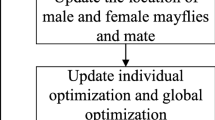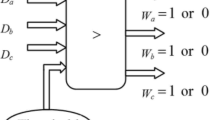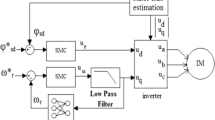Abstract
In order to detect the fault of induction motor quickly and accurately, a new fault detection method based on backstepping sliding mode observer is proposed in this paper. The new sliding mode observer has good robustness to unknown load disturbance, can effectively weaken the chattering phenomenon, and has better response speed and stability than exponential and traditional observers. Firstly, the backstepping controller is designed according to the mathematical model of induction motor. Secondly, based on the backstepping method, the sliding mode control is introduced, and a new reaching law sliding mode observer is designed to estimate the stator current and speed. After comparing the actual value with the observed value, the self-detection of induction motor fault is realized. Then, the Simulink model under different fault conditions is established to simulate the three faults of stator winding fault, rotor winding fault and simultaneous fault of stator and rotor winding. The comparative experimental results show that the new sliding mode observer based on backstepping can accurately and sensitively detect different types of early micro faults, which has a certain reference value for the engineering application of fault detection.
























Similar content being viewed by others
References
Babaie M, Sharifzadeh M, Kanaan HY, Al-Haddad K (2021) Switching-based optimized sliding-mode control for capacitor self-voltage balancing operation of seven-level PUC inverter. IEEE Trans Industr Electron 68(4):3044–3057
Ben Mohamed R, Dehri K, Elhajji Z et al (2021) A discrete terminal neuro-sliding mode control with adaptive switching gain for an uncertain nonlinear system. Iran J Sci Technol Trans Electr Eng. https://doi.org/10.1007/s40998-021-00454-5
Choi K, Kim Y, Kim S-K, Kim K-S (2021) Current and position sensor fault diagnosis algorithm for PMSM drives based on robust state observer. IEEE Trans Industr Electron 68(6):5227–5236
Chu X, Nian X, Xiong H, Wang H (2019) Robust distributed fault diagnosis for large-scale interconnected multi-motor web-winding systems. IEEE Access 7:181518–181530
Fan W, Zhou Q, Li J, Zhu Z (2018) A wavelet-based statistical approach for monitoring and diagnosis of compound faults with application to rolling bearings. IEEE Trans Autom Sci Eng 15(4):1563–1572
Gao Z, Cecati C, Ding SX (2015) a survey of fault diagnosis and fault-tolerant techniques-part II: fault diagnosis with knowledge-based and hybrid/active approaches. IEEE Trans Industr Electron 62(6):3768–3774
Huang X, Wu W, Yan W et al (2021) Sliding-mode control of gantry crane system with recursive least square parameters identification. J Ambient Intell Human Comput. https://doi.org/10.1007/s12652-021-03010-5
Jaskuła M, Leśniewski P (2020) Constraining state variables and control signal via sliding mode control approach. IEEE Access 8:111475–111481
Jiang D, Yu WX, Wang J, et al. (2020) Dynamic Analysis of DFIG Fault Detection and its Suppression Using Sliding Mode Control. IEEE Journal of Emerging and Selected Topics in Power Electronics 1–1
Jiang F, Sun SJ, Liu AM et al (2021) Robustness improvement of model-based sensorless SPMSM drivers based on an adaptive extended state observer and an enhanced quadrature PLL. IEEE Trans Power Electron 36(4):4802–4814
Jimenez Garibay A, Juvenal Rodriguez-Resendiz JR, Jauregui Correa J (2018) Analysis of rotor current impact on DFIG-WECS under fault condition. IEEE Lat Am Trans 16(2):329–334
Kumar PS, Xie L, Halick MSM, Vaiyapuri V (2021) Stator end-winding thermal and magnetic sensor arrays for online stator inter-turn fault detection. IEEE Sens J 21(4):5312–5321
Lee H, Jeong H, Koo G, Ban J, Kim SW (2021) Attention recurrent neural network-based severity estimation method for interturn short-circuit fault in permanent magnet synchronous machines. IEEE Trans Industr Electron 68(4):3445–3453
Mahmud M, Wang W (2021) A smart sensor-based cEMD technique for rotor bar fault detection in induction motors. IEEE Trans Instrum Meas 70:1–11
Mekki H, Benzineb O, Boukhetala D, Tadjine M, Benbouzid M (2015) Sliding mode based fault detection, reconstruction and fault tolerant control scheme for motor systems. ISA Trans 57:340–351
Meng F, Wang D, Liu Z, Su W (2021) Fast circuit-field coupling analysis for skewed induction motor. IEEE Trans Industr Electron 68(6):5088–5099
Mojallal A, Lotfifard S (2018) Multi-physics graphical model-based fault detection and isolation in wind turbines. IEEE Transactions on Smart Grid 9(6):5599–5612
Morawiec M, Lewicki A (2021) Speed observer structure of induction machine based on sliding super-twisting and backstepping techniques. IEEE Trans Industr Inf 17(2):1122–1131
Salazar-Herran E, Martin-Escudero K, del Portillo-Valdes LA, Flores-Abascal I, Romero-Anton N (2020) Flexible dynamic model of PHEX for transient simulations in Matlab/Simulink using finite control volume method. Int J Refrig 10:83–94
Taimoor M, Aijun L, Samiuddin M (2021) Sliding mode learning algorithm based adaptive neural observer strategy for fault estimation, detection and neural controller of an aircraft. J Ambient Intell Human Comput 12:2547–2571
Thabet A, Gasmi N, Frej GBH, Boutayeb M (2021) Sliding mode control for Lipschitz nonlinear systems in reciprocal state space: synthesis and experimental validation. IEEE Trans Circuits Syst II Express Briefs 68(3):948–952
Tian Y, Zhang K, Jiang B (2020) Fault detection of induction motor based on interval observer. Control Eng 27(06):927–933
Wang AM, Wei SJ (2020) Research on sliding mode control of permanent magnet motor based on improved exponential reaching law. J North China Electr Power Univ (NATURAL SCIENCE EDITION) 47(01):50–57
Wang G, Hao X, Zhao N, Zhang G, Xu D (2020) Current sensor fault-tolerant control strategy for encoderless PMSM drives based on single sliding mode observer. IEEE Trans Transp Electr 6(2):679–689
Yi L, Liu Y, Yu W, Zhao J (2020) A novel nonlinear observer for fault diagnosis of induction motor. J Algorithms Comput Technol. https://doi.org/10.1177/1748302620922723
Yi L, Xu X, Zhao J et al (2021) Fault detection of induction motor based on ALO optimized TKSVDD. J Electr Eng Technol 17(1):381–393
Yu WX, Jiang D, Wang J, Li R, Yang L (2020) Rotor-current-based fault detection for doubly-fed induction generator using new sliding mode observer. Trans Inst Meas Control 42(16):3110–3122
Zhang X, Han X (2021) Simulation and sliding mode control of large oil tanker yaw chaos. J Shanghai Jiaotong Univ 55(01):40–47
Zhang CF, Huang YS, Shao R (2011) Observer based fault detection method for induction motor and its application. J Instrum 32(06):1337–1343
Zhang Y, Yin Z, Li W, Liu J, Zhang Y (2021) Adaptive sliding-mode-based speed control in finite control set model predictive torque control for induction motors. IEEE Trans Power Electron 36(7):8076–8087
Acknowledgements
This work was supported by the National Natural Science Foundation of China (61572416), Hunan province Natural science Zhuzhou United foundation (2020JJ6009), Postgraduate Scientific Research Innovation Project of Hunan Province (QL20210153), Key Laboratory Open Project Fund of Disaster Prevention and Mitigation for Power Grid Transmission and Transformation Equipment.
Author information
Authors and Affiliations
Corresponding author
Ethics declarations
Conflict of interest
The author(s) declared no potential conflicts of interest with respect to the research, authorship, and/or publication of this article.
Additional information
Publisher's Note
Springer Nature remains neutral with regard to jurisdictional claims in published maps and institutional affiliations.
Rights and permissions
About this article
Cite this article
Yi, L., Sun, T., Yu, W. et al. Induction motor fault detection by a new sliding mode observer based on backstepping. J Ambient Intell Human Comput 14, 12061–12074 (2023). https://doi.org/10.1007/s12652-022-03755-7
Received:
Accepted:
Published:
Issue Date:
DOI: https://doi.org/10.1007/s12652-022-03755-7




